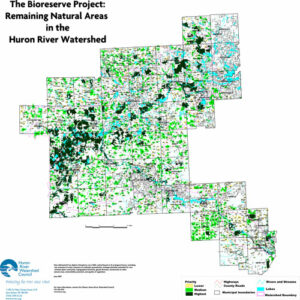Protecting the “Right Land,” The power of partnership for effective conservation
HRWC works to protect natural lands from development as our remaining natural areas are critical to the health of our watershed. Forests, wetlands, and prairie ecosystems provide numerous benefits to water quality, including groundwater recharge areas, pollution filtration, erosion control, and surface water retention. We partner with local land conservancies, municipal land protection programs, and other conservation organizations to engage communities and property owners in protecting land via conservation easements and direct purchase of land for preserves. Kris Olsson has been the driving force behind these partnerships for HRWC, as described in the following article by Guest Author Susan Lackey. This article is republished from our Spring 2024 Huron River Report, celebrating Kris’s retirement.
Protecting Land Protects Water Quality
In Michigan, land conservation and water quality are inextricably linked. Land well away from rivers and streams can be important to water quality. Sorting those properties out from all the others in our rapidly changing area is frequently a struggle for land conservancies. Fifteen-plus years ago, before the easy availability of GIS (geographic information system) data and analytics software, it was even harder.
In the mid-2000s, Legacy Land Conservancy committed to increased and targeted land protection, with an emphasis on protecting ‘the right lands.’ We were focused on farmland, publicly accessible lands, and land that protected water quality. The first two were pretty simple—soils, size, and adjacency to existing public lands are obvious criteria. But we struggled with how to ramp up our efforts to protect land that had the greatest impact on water quality.
Then, one day, Kris Olsson wandered down the hall at the NEW Center, where we both had offices. She brought along a map and some data, and asked, “Are you interested in this?” Were we ever! That first iteration of the Bioreserve Project (now called the Natural Areas Assessment Program) became a starting point for us as we prioritized our work in the Huron River watershed. Later, we adapted that initial methodology to prioritize our efforts in the River Raisin and Grand River watersheds.
Using the Bioreserve Map to Inform Conservation

As Kris and her volunteers started to ground truth the study by conducting field assessments of natural lands identified in the initial Bioreserve Project, the Bioreserve Map became even more important to our work. In places like Arms Creek and Portage Creek, it became the tool for deciding where to focus our land protection efforts. In those targeted communities, Legacy and HRWC sent joint mailings to landowners, offering field assessments and information on land management and protection. This opened doors for a more in-depth conversation about conservation, and the importance of a piece of land that might have seemed valuable only to the landowner.
Legacy wasn’t the only conservancy in southeast Michigan to benefit from Kris’s work. A coalition of regional land conservancies, under the umbrella of SEMI-wild, chose the Huron River for their first coordinated land protection efforts, in no small part because of the Bioreserve data and the cooperation of Kris and HRWC. Again, the completion of field assessments and outreach to landowners helped open doors and begin conversations. Today, some of that same work is helping to guide the Washtenaw County Natural Areas Protection Program in its efforts to maximize the impact of land protection funding.
Sharing Resources to Expand Land Assessment and Protection
Under Kris’s guidance, HRWC looked more closely at the relationship between land protection and water quality. Watershed management plans more frequently identified land protection as a desirable tactic to improve water quality, and pinpointed areas where land protection programs should focus our work. These plans are a key to securing funding for the purchase of conservation easements.
Efforts to support farmland protection followed, including a tool kit for communities seeking to maintain their rural heritage. With that came a growing understanding on the part of local officials and landowners that, indeed, farmland protection could be water quality protection.
When Kris first trekked down to Legacy’s office, she brought something else with her: a field guide she was developing that showed key indicator plant species in our area. I think about her field guide often as a member of the Washtenaw County Natural Areas Technical Advisory Committee. Today, her plant ID skills are awesome. Of course, the field guide has long been replaced by smartphone apps. But in its day, Kris’s field guide was portable and targeted—so important when you’re wandering around the woods.
Kris’s Legacy of Collaborating for Land Protection
Kris has been instrumental in bringing better science to what had long been a land protection effort based on common sense and willing landowners. Those factors haven’t gone away, but now they are bolstered with confidence that these are the right properties for protection.
The largely urbanized Huron River watershed has a limited opportunity to solidify water quality through land protection. Kris’s willingness to work with land protection partners encouraged us to set aside our competitive differences and work together. Collectively, we’re working to ensure the health of the Huron River and its surrounding lands well into the future. That work will be a lasting legacy for the region, and it wouldn’t have happened without Kris. As she retires from HRWC, I know she’ll be missed, but I know she won’t stop caring about or working for the health of the river.
—Susan Lackey, Former Executive Director of Legacy Land Conservancy, former President of the Board of Directors at Heart of the Lakes Center for Land Policy, and current member of the Washtenaw County Natural Areas Technical Advisory Committee
HRWC asks you to please consider contributing to the Watershed Resilience Endowment Fund and join Kris’s fight for the protection of our watershed and river forever. Help us honor Kris’s thirty-one-year legacy as she retires from HRWC.



